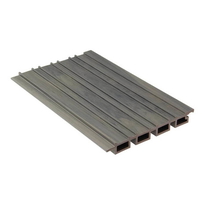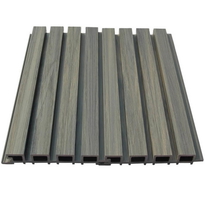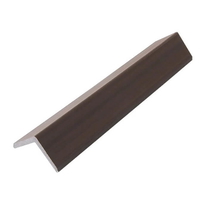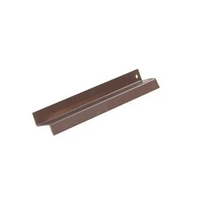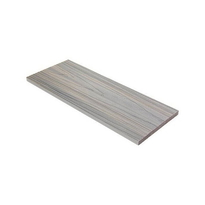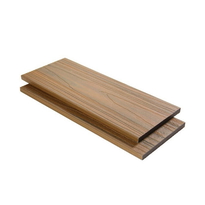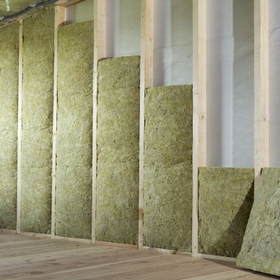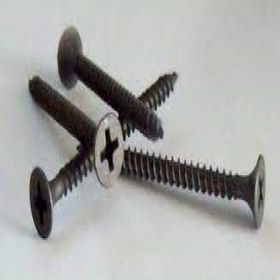Similar Categories
Types of External Cladding Boards
There are several types of external cladding boards available in the UK, each offering different features and advantages for building facades.
Timber cladding boards, made from softwoods such as Western Red Cedar and Douglas Fir, are popular for their natural appearance and insulation benefits. They often feature shiplap profiles with a curved aesthetic and utilise rhomboid-shaped rainscreen profiles for a modern style, although they do require regular maintenance and protective coatings. (Softwoods like Western Red Cedar are highly durable and decay-resistant, making them suitable for exterior use.) Brick and brick slip cladding provide a classic appearance, are durable, and low maintenance; however, installation can be labour-intensive.
Stone and stone veneer offer a natural, luxurious look, with high weather resistance and durability.
Metal cladding, including aluminium and steel, is notable for its fire resistance, sustainability, and capacity to create contemporary designs.
Popular Materials for Cladding Boards
A variety of materials are used for external cladding boards in the UK, each offering different benefits in terms of appearance, durability, and cost.
Aluminium composite materials (ACM) consist of two aluminium layers with a polyethylene core, making them durable and low maintenance. ACM is often chosen for its lightweight nature and modern aesthetic. Fibre cement combines strength with affordability and long-lasting qualities, although it requires professional installation. Aluminium cladding is budget-friendly and fire-resistant but can dent and rust over time. Brick provides a traditional look and sturdy construction, while terracotta offers customised, attractive exteriors with a timeless feel.
Each material appeals to homeowners seeking a balance between style and practicality. Whether prioritising low upkeep, aesthetic appeal, or environmental impact, these options present a range of choices to create a welcoming, attractive exterior.
Installation and Maintenance of Cladding Boards
Before installing external cladding boards, proper preparation is essential to ensure a secure and lasting fit. All cladding must be attached to a subframe made of materials such as timber, plastic, composite, or metal joists.
Battens should be spaced evenly, taking into account the board size and aesthetic preferences, and attached to a vertical support structure with appropriate fasteners. Ensuring level battens and adhering to local building regulations are vital steps.
It's important to leave gaps for ventilation and expansion to prevent damage from temperature changes. When installing, begin from the bottom, using starter fasteners, and secure the boards to the battens with the manufacturer’s recommended fasteners.
Maintain expansion gaps, especially at butt-ends, and utilise concealed grooves for a seamless appearance. Regularly inspect, clean, and promptly repair any damage to extend the lifespan of the cladding.
Aesthetic and Design Options for Cladding Boards
External cladding boards offer a wide array of aesthetic and design options that can enhance the appearance of any building. Various textures and finishes help create unique visual effects, ranging from rugged stone styles to smooth, sleek metal or vinyl surfaces. These options allow for customization to suit different architectural styles and personal preferences. Colour choices, including neutrals, vibrant hues, and natural variations, add personality and sophistication. Patterns such as horizontal, vertical, or diagonal layouts influence the overall look and feel of the building. Material options like brick, timber, metal, or stone provide distinct styles, from traditional to contemporary, allowing builders and owners to express their preferences. Advanced finishes and custom milling add depth, durability, and creative freedom. These design options help craft buildings that feel connected to their environment and reflect individual tastes, fostering a sense of belonging through thoughtful design.
Durability and Performance of Cladding Boards
Durability and performance are crucial factors in how well cladding boards withstand weather conditions, the passage of time, and everyday use.
High-quality materials, such as composite cladding—which combines wood fibres and recycled plastics—offer superior resistance to rot and moisture, making them more durable than traditional timber options. Composite cladding's composition emphasizes its ability to endure challenging environments and maintain appearance over many years. Exterior systems like External Insulation and Finish Systems (EIFS) effectively manage moisture levels, helping to prevent damage from water ingress.
Proper installation is vital; incorrect methods can result in leaks or structural problems.
Materials like capped composite provide additional protection against scratches and stains, thereby extending their lifespan.
Regular maintenance, including consistent cleaning and inspections, also plays a significant role in ensuring longevity.
Environmental Impact and Sustainability of Cladding Boards
The environmental impact of cladding boards is influenced by their manufacturing processes, usage, and recyclability.
Materials such as vinyl and composites typically exhibit lower life cycle impacts as they often incorporate recycled content and require less energy for production.
Understanding these factors is essential for comparing their sustainability and selecting more environmentally friendly options.
Lifecycle and Recyclability
Understanding the environmental impact and sustainability of cladding boards requires examining their entire life cycle, from raw material extraction to end-of-life disposal. Raw material extraction can harm ecosystems and contribute to climate change, particularly depending on the material used. During manufacturing, significant carbon emissions are produced, with different materials varying in their environmental footprint. Installation and maintenance generate waste, but selecting durable materials helps reduce long-term impacts. When old cladding reaches the end of its life, proper disposal and recycling are vital to avoid landfill accumulation and pollution. Some materials, such as wood, are biodegradable and recyclable, while others, like vinyl, present challenges due to toxic components. Implementing recycling programmes and designing for recyclability play essential roles in minimising overall environmental effects. Recycling initiatives can greatly reduce waste and conserve resources, supporting sustainable construction practices.
Material Sustainability Levels
Different cladding materials vary significantly in their environmental impacts and sustainability levels.
Composite cladding is often regarded as the most eco-friendly option, as it utilises recycled and ethically sourced materials, thereby reducing waste.
Wood cladding, although biodegradable, is associated with deforestation and transportation emissions, which can adversely affect the environment.
Vinyl cladding is durable but contains harmful chemicals like PVC, which can lead to water pollution and the production of smog.
Brick and mortar have considerable environmental impacts due to raw material extraction and manufacturing processes.
Fibre cement generally has a higher impact than vinyl.
Some sustainable alternatives include Accoya wood, reclaimed wood, and recycled vinyl, all of which help to lower the environmental footprint.
As awareness increases, the industry is shifting towards greener choices, fostering a sense of community dedicated to protecting our environment. Advances in eco-friendly manufacturing are continually improving the sustainability profiles of these materials, making greener options more accessible to consumers.
Energy Use During Production
Energy use during the production of cladding boards plays a significant role in their overall environmental impact. Different materials require varying amounts of energy; for example, aluminium and cement-based products demand more energy, whilst SIPs consume less. Recycling can reduce energy use, especially in metal panels, by reusing materials rather than creating new ones. Innovative techniques such as energy recovery systems and cleaner kilns help to lower emissions and waste.
| Material | Energy Intensity | Sustainability Benefits |
|---|---|---|
| Aluminium | High, but reduced with recycled content | Recycling reduces energy needs |
| Brick | Moderate, with energy-saving technology | Cleaner kilns lower emissions |
| SIPs | Low in energy consumption | Less waste during manufacturing |
Conclusion
External cladding boards offer versatile options for building exteriors, with choices that vary in material, appearance, and performance. Proper installation and maintenance guarantee longevity, while consideration of environmental impacts helps promote sustainability. Understanding the different types and features allows homeowners and builders in the UK to select suitable boards that meet aesthetic, durability, and ecological needs. Overall, cladding boards provide an effective way to enhance a building's appearance and protect it from the elements, supporting both functionality and design.
